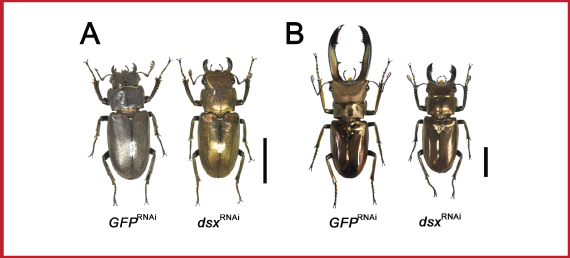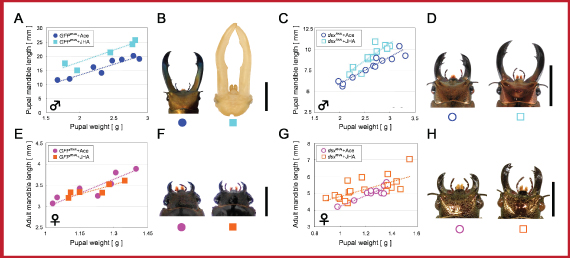Gene Causing Sexual Dimorphism in Stag Beetles Successfully Identified
Research Press Release | February 14, 2014
-
 Figure 1.Material species Cyclommatus metallifer used in this study. Male (right) has extremely enlarged mandibles compare to female (left). Scale bar: 20mm
Figure 1.Material species Cyclommatus metallifer used in this study. Male (right) has extremely enlarged mandibles compare to female (left). Scale bar: 20mm -
 Figure 2.Resulted phenotypes of dsx gene knockdown (A) In females, control individuals (left) had no detectable defects compare to normal wild type individuals, however, dsx knockdown individuals (right) showed intersex phenotype such as golden body color and enlarged mandibles. Scale bar: 10mm (B) In males, control individuals (left) had no detectable defects compare to normal wild type individuals, however, dsx knockdown individuals (right) showed intersex phenotypes characterized in shorter mandibles. Scale bar: 10mm
Figure 2.Resulted phenotypes of dsx gene knockdown (A) In females, control individuals (left) had no detectable defects compare to normal wild type individuals, however, dsx knockdown individuals (right) showed intersex phenotype such as golden body color and enlarged mandibles. Scale bar: 10mm (B) In males, control individuals (left) had no detectable defects compare to normal wild type individuals, however, dsx knockdown individuals (right) showed intersex phenotypes characterized in shorter mandibles. Scale bar: 10mm -
 Figure 3.Effects of JH application on GFPRNAi and dsxRNAi individuals. The relationships between pupal weight and mandible length were described. Sex is indicated by color of symbols (male: blue and light blue, female: pink and orange). Hormone treatments are indicated by shape of symbols (acetone treatment: circle, JH treatment: square). RNAi treatments are distinguished by closed (GFP dsRNA injection) or open (dsx dsRNA injection). Scale bars indicate 10 mm (in males) or 5 mm (in females). X-axes indicate body size and Y-axes indicate mandible length in A, C, E, G. Females expressing dsx did not show JH-induced mandible overgrowth (E, F). However, in dsx knockdown females, JH treatment induced mandible overgrowth (G, H). In males, JH treatment induced mandible overgrowth regardless of dsx expression (A-D).
Figure 3.Effects of JH application on GFPRNAi and dsxRNAi individuals. The relationships between pupal weight and mandible length were described. Sex is indicated by color of symbols (male: blue and light blue, female: pink and orange). Hormone treatments are indicated by shape of symbols (acetone treatment: circle, JH treatment: square). RNAi treatments are distinguished by closed (GFP dsRNA injection) or open (dsx dsRNA injection). Scale bars indicate 10 mm (in males) or 5 mm (in females). X-axes indicate body size and Y-axes indicate mandible length in A, C, E, G. Females expressing dsx did not show JH-induced mandible overgrowth (E, F). However, in dsx knockdown females, JH treatment induced mandible overgrowth (G, H). In males, JH treatment induced mandible overgrowth regardless of dsx expression (A-D).
| Press Release | ||
|---|---|---|
| Key Points | ・The gene that causes sexual dimorphism in stag beetles has been identified.
・When the function of this gene is inhibited stag beetles showed neutral characteristics between male and female. ・The gene regulates mandible*1 growth, which differs significantly in size between males and females. ・This gene may regulate the responsiveness to hormones that promote mandible growth. ・Experimental evidence of morphogenetic regulation by sex-determination gene via hormone signaling in insects is rare so far. ・These results are considered to be important in the understanding of the mechanism which causes sexual differentiation in insects. *1 Mouth parts of insects. Significant mandible growth is observed in male stag beetles. In Japan, these parts are commonly called “hasami” (meaning scissors in Japanese). |
|
| Overview |
The morphological difference between male and female stag beetles is widely known. Male stag beetles have a pair of fully developed mandibles that are commonly called “hasami,” while females do not exhibit such mandible growth. What is the mechanism that causes such significant difference within the same species? In order to understand this mechanism, a developmental study was carried out on Cyclommatus metallifer, focusing on sex-determination genes and juvenile hormone*2 signaling pathways. Results indicate that the dsx gene, a sex-determining gene for insects, regulates sexual dimorphism in stag beetles. It is also suggested that a large difference in sexual dimorphism of mandible growth is due to the dsx gene that regulates juvenile hormone responsiveness in different directions depending on whether the individual is male or female. These results are a major milestone, and mark the discovery of the “sexual differentiation regulatory mechanism by the dsx gene via hormone responsiveness,” which is relatively unknown in the insects. This finding is also important in the understanding of the mechanism which causes phenotypic sexual dimorphism in other insects as well. *2 A type of insect hormone which is known to be involved in various biological phenomena in insects, such as development and metamorphosis. In addition, the growth-promoting function of this hormone on the mandibles of the stag beetle has been identified. |
|
| Inquiries |
Toru Miura, Associate Professor, Graduate School of Environmental Earth Science, Hokkaido University TEL & FAX: +81-11-706-4524 E-mail: miu@ees.hokudai.ac.jp Laboratory of Ecological Developmental Biology |
|
|
Japanese Link |
||
| Publications |
PLoS Genetics (2014.1.16) |
|
